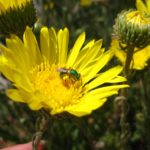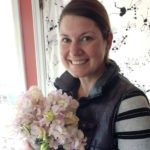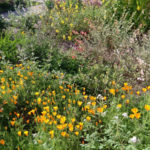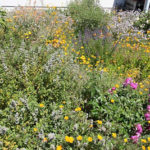Pollinator Gardening Tips
by Guest blogger: Jaime Pawelek
of Wild Bee Garden Design
Listen to her podcast HERE
Gardens can serve many functions in our lives, but they can also help conserve valuable wildlife, including pollinators, like bees, butterflies, wasps, flies and hummingbirds. Not only can you grow your own food and medicine, but you can cultivate a garden that supports pollinators at the same time. The number one pollinators of most ecosystems are bees, of which there are over 4,000 species in North America alone! While most people only know about honey bees, there are actually many more types out there pollinating our crops, wildflowers, and native plants. Many species of bees have also adapted to live in our urban habitats including bumble bees, carpenter bees, digger bees, squash bees, sweat bees, mason bees, leaf-cutter bees and cuckoo bees (plus many more!).

Many species of pollinators have been in decline due to increased use of pesticides and herbicides, loss of habitat, climate change, and introduced diseases and pests. Urban areas once thought of as being devoid of life, have actually been found to support many species of bees and other pollinators in recent years. This is great news to home gardeners and plant enthusiasts because we can all do a small part to help conserve these valuable creatures. We can create pollinator-friendly gardens or modify existing gardens to provide food, shelter, water and places to raise young. These small gardens throughout an urban area can provide connectivity for wildlife and bountiful resources for them to enjoy.
Here are some tips for encouraging these winged beauties into your garden space:
- Research flowering native plants in your area and find out which ones do well in gardens. Native bees evolved with native plants so they are naturally pre-programmed to want to visit them in search of food (nectar and pollen). Master gardener groups, cooperative extension, and native plant society chapters are great resources for this information and often they provide plant lists for your specific region. Many non-native plants are great bee attractors too, so get out there and start observing to see which are the most popular to your local bees.
- Choose plants that bloom from early spring to late fall and even a bit into winter for more milder climates. Bees are seasonal and come out at different times of year, so it’s important to have a food source for them blooming all season long. This info should be easy to find as you are researching the native plants of your region.

- Plant in large patches. Select one plant species and plant several individuals together forming as large a patch as you can, ideally covering at least 3ft x 3ft. When bees are foraging, they typically stick to one plant type and look for the same one over and over. By planting a large patch of the same plant, you allow the bee to hang out for longer instead of having to search for more of the same flower.
- Select a variety of flower shapes, sizes and colors for the various types of native bees and other pollinators that may be visiting. Some bees have long tongues and can reach the sugary nectar at the bottom of a long tubular flower, while others prefer to shimmy and dance on top of a composite flower in order to collect as much pollen as possible. By increasing the diversity of flower shapes and colors, you allow for more diversity in the pollinators visiting your garden as well.

- Provide water by putting a few large rocks in your bird bath, or by floating a piece of cork. These are used by bees as a landing spot so they don’t drown in the water. Honey bees need a source of water, while most native bees get enough water from plant nectar. Some bees, like mason bees, might collect water in order for them to make the mud they need for constructing their nests.
- Allow bees to make homes in your garden by leaving some bare soil exposed, or by providing holes for cavity nesting bees. Most bees nest underground and they need access to bare soil in order to dig their holes, so pull back the mulch in some areas, or leave some out of the way place wild and weedy for them to inhabit. Cavity nesting bees benefit from hollowed out stems or holes drilled in wood. There is lots of info online on how to build them. Most of these bees are solitary and don’t have a large colony of helpers like honey bees, so even a small space is good enough for them.
- If you already have a garden, look to see if there are areas that could be changed or modified slightly to help encourage bees. In between vegetables, you can add flowers like cosmos, poppies, basil, or calendula. Areas underneath and around fruit trees can also be planted for pollinators. Existing wood structures can have holes drilled in them for cavity nesting bees. Bundles of dried hollow stems or bamboo can be tied around the garden for nesting bees as well. Adding containers or hanging planters with bee plants can also add food for visiting pollinators. A fence can be a great structure for a passionflower vine to cling to and provides food for bees as well as for certain butterfly larva.
Gardens are dynamic and always transforming, so consider adding pollinator habitat to yours and enjoy the changing colors and buzzing visitors throughout the year.
UrbanFarm.org/pollinatortips
About this author:
 Jaime is the owner of Wild Bee Garden Design and has been studying native bees for nearly 15 years. She graduated from UC Berkeley with a degree in Conservation and Resource Studies in 2008. At the university, she worked in the Urban Bee Lab with Dr. Gordon Frankie for several years where she learned about the close relationships of bees and plants by observing their interactions all across California.
Jaime is the owner of Wild Bee Garden Design and has been studying native bees for nearly 15 years. She graduated from UC Berkeley with a degree in Conservation and Resource Studies in 2008. At the university, she worked in the Urban Bee Lab with Dr. Gordon Frankie for several years where she learned about the close relationships of bees and plants by observing their interactions all across California.
With the information she learned, and started designing gardens full of native and drought tolerant plants for homeowners and businesses to help them create valuable pollinator habitats. She currently works as a taxonomist identifying bees for various researchers around the country.
How to reach Jaime:
Website: http://wildbeegardendesign.weebly.com/
Email: wildbeegardendesign@gmail.com





Your tips are helpful. Very well written. Thanks for sharing.
Fantastic tips!